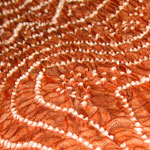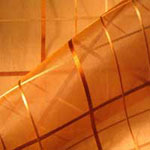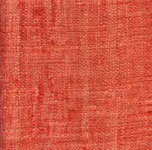 |
Batik / bə•tēk / The word originates from Javanese, the word amba meaning to write, and titik meaning dot or print. Indonesia, Africa and India are widely known for making Batik cloth. Using wax as a dye resist is the common feature of batik, however, traditional applying techniques and motifs differ by region. Indian artisans use carved wooden blocks and brushes to apply the wax. Using this labor intensive technique, the artisans can create a range of designs including multi-colored and richly layered scenes. The indicative cracked wax effect of batik occurs when the hardened wax cracks while being handled and submerged in a dye bath.
click on image for a larger view
|
 |
 |
Bandhani / bän•də•nē, bän•dnē / The term bandhani derives its name from a Hindi word Bandhan which refers to tying up. Bandhani is a special form of tie dyeing that involves the use of thread for knotting. Select areas of the fabric are pinched, pulled and tightly wrapped with thread. The fabric is then piece dyed, and after drying, the threads are removed revealing the undyed base fabric. The wrapping and tying results in permanent wrinkles in the fabric which are part of the design. The quality can be determined by the size of the dots: the smaller and closer to the size of the pinhead the dots are, the finer the quality. This process is not exclusive to India. In Japan, there is a wide range of techniques to manipulate fabric for resist dyeing, but all of them are commonly referred to as Shibori.
click on image for a larger view
|
 |
 |
Crewel Embroidery / krōō•əl / A chain stitch embroidery technique using colored wool yarns. Traditionally done on a rustic canvas cloth (dosooti) for home furnishing items, and on lightweight wool for shawls and scarves. The chain stitch is done by hook (Ari) rather than a needle.
click on image for a larger view
|
 |
 |
Dupione / doo•pē•ō•nē / Fabric woven from silk yarns made of thread from the cocoon of 2 silk worms that have nestled together. The yarns have an irregular denier which when woven produce a fabric that is recognized for its irregularity and slubs. Silk dupione is also notable for its body and luster. In China, this fabric is referred to as Shantung, named after the Shandong region where it was woven. While both fabrics have similar characteristics, Shantung is stiffer and has fewer slubs, and Dupione can only be yarn dyed, even for solid colors.
click on image for a larger view
|
 |
 |
Ikat / ī•kät, ē•kät / A complicated dyeing technique applied to the yarns prior to weaving which will create designs on the finished fabric. Specific portions of the warp and/or weft threads are wrapped with rubber strips to prevent them from absorbing color. Each color is dip dyed and wrapped until all the colors have been applied. Each thread will have different colors along its length. Great care must be taken in putting the warp on the loom, keeping all the threads in position is necessary for the design to work. The natural movement of the warp during the weaving process gives Ikat designs a feathered edge which characterizes the work.
click on image for a larger view
|
 |
 |
Kalamkari / käl•um• kär•ē / The origin of the term kalamkari is Hindi meaning pen art. Kalamkari is the earliest technique of block printing on cloth using vegetable dyes. The traditional process is complex and intricate, and the blocks are made by specialist artisans. Often, the printed designs are characterized by winding, flowering vines that are outlined with black ink. The color fixing process is involved and complicated, and as a result the piece length for running yardage usually does not exceed 6 yards for heavy cloth and 12 yards for shirting weight fabric.
click on image for a larger view
|
 |
 |
Madras / mə•dräs, mad•rəs / A light weight cotton fabric woven in Madras (recently renamed Chennai). Woven in plaids and check patterns, it became very popular in the West for shirts and dresses. Vegetable dyes were used early on which would bleed when laundered, creating a distinct look and name: bleeding madras. The specific yarn size used in making madras fabric is 40 singles in the warp and weft, although a 2 ply warp 2/40s is used when making pants and skirts.
click on image for a larger view
|
 |
 |
Organza / ôr•gan•zə / A sheer, lightweight silk fabric made from semi bleached undegummed yarn (Kora). It’s stiff, and has a slight rasp to the hand. When washed, especially in warm water, the gum (sericin) comes out gradually making the fabric softer and more drapey over time.
click on image for a larger view
|
|
 |
Raw Silk (fabric) / rôw silk / This misnomer is commonly used to refer to any silk fabric marked by a rustic appearance, irregular surface texture, semi bleached or natural shade, striated color, or matte finish. See Tussah Silk.
Raw Silk (yarn, thread) Silk filament covered in Sericin, its protective layer of gum from the cocoon. Also referred to as un-degummed, which is how silk is stored until ready for bleaching and dyeing.
click on image for a larger view
|
|
| |
Selvedge / sel•vij / The woven, outside edge of a fabric. Usually ¼” -1” wide and made with a different color thread, the selvedge has a tighter construction than the body of the fabric which prevents it from unraveling. The selvedge is excluded from the cutable width of a fabric.
|
|
 |
Tussah Silk / tus•ə / Produced from uncultivated silkworms that live in the wild, and generally referred to as raw silk or wild silk. Tussah silk is notable for its rough texture and beautifully varied shade of ecru and tan. It is difficult to bleach, and therefore dyes unevenly.
click on image for a larger view
|
 |
| |
Warp / wôrp / Vertical threads of a fabric. Applies to threads which run the length of the fabric. The warp yarns are set up on a loom, and manipulated - moving up and down with each passing of the weft thread.
|
|
| |
Weft / weft / Relates to horizontal threads. On a loom, the shuttle travels back and forth across the width of the fabric carrying the weft thread which passes over and under the warp threads.
|
|
| |
back to top |
|
| |
|
|